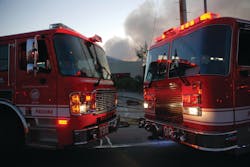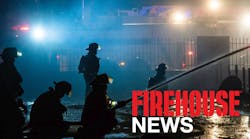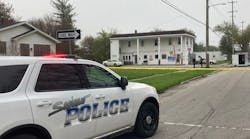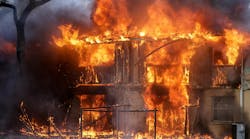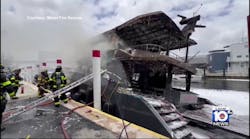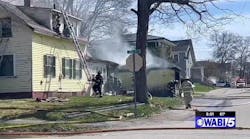The quick answer to this question is a resounding “NO.” You don’t need to respond to all “911” calls in an emergency fashion. The operative word in this question is all.
The success or failure of fire service emergency and non-emergency functions is dependent on the safe operation of fire department vehicles. “Arrive Alive,” a slogan popular with first responders, points directly to the fact that if we don’t arrive safely to help the customer, we are no good to anyone. In fact, not arriving at all because you’ve been in an accident will add complication to the first emergency call. Without the safe operation of emergency vehicles to incident scenes, an emergency service organization cannot effectively achieve its mission of saving lives and protecting property.
Responding emergency versus non-emergency is a matter of risk management. How much risk is the fire chief willing to assume or tolerate? Members will practice risk management based on the example set by department leadership. Poor safety records, demonstrated by workplace injuries and death, are frequently the result of inadequate or ignorance towards reducing risk to first responders.
Risk management is a comprehensive approach to safe workplace practices. Practitioners of risk management recognize the landscape is continually changing and must consider how this impacts their organization. Success, as measured by a safer work environment, is best achieved through focused and coordinated efforts. The question discussed in this article focuses on reducing risk during emergency responses. This is an important topic and progressive fire service leaders consider risk management to be a top priority of their organizations.
Traffic dangers
One of the more significant occupational risks, in terms of injury and death to firefighters, is traffic collisions involving fire apparatus. In 1999, a study authored by the Center for National Truck Statistics found that fire apparatus (defined as using emergency signals on the vehicle) were involved in 62% of the fatal accidents surveyed and 56% of non-fatal accidents. The study also found that when fire apparatus were involved in accidents with other vehicles, fatal injuries most often occurred in the civilian vehicle, with injuries occurring in 24% of the crashes. Seventy-six percent of the accidents tabulated involved property damage to some degree. The results are closely linked to the size and weight of fire apparatus in comparison to the passenger vehicles with which they collided.
Historically, some American fire service agencies have resisted efforts to reduce line-of-duty deaths attributed to emergency responses, although more departments are recognizing the need to reduce risk when responding by “managing” their responses. We will elaborate on a managed response shortly.
Managing risk is a fundamental responsibility at every level of management in the organization, but especially for top leadership. The term “risk management” can be applied to a wide range of functions and activities, requiring a multi-faceted approach that encompasses many elements within the delivery of emergency services. These elements include safety and health programming, financial and loss control. Our discussion will focus on the delivery aspect of our service – the response – and reducing risk while responding. It is a fundamental principle of risk management to identify areas where risk can be reduced or eliminated. Using the chart below, let’s look at reducing or eliminating risk when responding.
Risk management through the use of technology enhancements offers options for a safer response. These tend to be viewed as quick and simple “solutions” that can, in some cases, be expensive. Examples include occupant-restraint systems, vehicle-speed governing and monitoring, traffic pre-emption equipment and driver-training simulators. Administrative guidelines and monitoring are common mechanisms in efforts to identify and reduce risk.
Having sound emergency vehicle response guidelines in place will assist the department by providing clear direction to its officers and drivers. These are considered process-oriented and must go hand-in-hand with our final element – people. Placing people in the correct assignment based on knowledge, skill and attitude, combined with a robust training program, is considered the best long-term solution when addressing risk in the workplace. One simple strategy is to increase the awareness to specific risk areas through an active communication process.
If an ethical or moral responsibility doesn’t compel the fire chief to consider a risk management approach for incident response, then perhaps the threat of legal proceedings might prompt action. In a previous article, we spoke of the legal concept of misfeasance, taking an action determined to be inappropriate even if with good intent. When misfeasance is applied to our incident response protocols, we should ask, “Have we taken all reasonable steps to reduce risk to our responders and the public while responding? Have we defined our response protocol through a practical, rational and calculated manner? Or is our response defined by subjective reasoning?”
Managed response
Let’s use a fire alarm response as a basis in designing a managed response. A managed response infers that our decision is based on an objective, balanced and deliberate assessment in an effort to reduce response risk. For example, let’s use an outcome-based review of 100 fire alarms received. Following a review of the fire incident report, we find that 15% of the total responses resulted in an actual fire or smoke event. Of the total events (100), 55% were to single-family dwellings, 35% were to multi-family units and 10% were to commercial occupancies. In outcomes where fire or smoke were evident, eight events occurred in multi-family dwellings, five in single-family and two in a commercial structure. When we look at time of day when the call was received, we find that an overwhelming majority, 70% of the total, occurred between 6 A.M. and 6 P.M. Of the 15% with fire or smoke on arrival, 10 events occurred after 6 P.M.
Based on our review of 100 fire alarm events, we found that although most occurred during normal business hours, only 15 of them had smoke or fire evident on arrival. Of these, most occurred in single-family dwellings. From a risk-management perspective, a managed response seems appropriate and should be considered. The following chart illustrates a managed-response plan, identifying apparatus and response mode. The officer or senior member has the authority to alter the response plan based on information received, weather/road conditions, available resources, etc.
In this scenario, it is a requirement for the dispatcher to contact the alarm location to verify if a problem exists or not. This is done following the dispatch of the fire department. The information provided by the dispatcher is then used by the officer in deciding the response mode.
When considering your response mode, keep in mind that the primary responsibility of all fire chiefs is personnel safety – providing a safe work environment for their members. Reducing risk to our responders requires a thoughtful and practical decision making approach. Modifying your response to non-life-threatening events will reduce risk to responders and vastly improve the chances that we “arrive alive.”
(Campbell, K.L. (1999). Traffic Collisions Involving Fire Trucks in the United States. Center for National Truck Statistics, University of Michigan Transportation Research Institute, UMTRI 99-26.)
